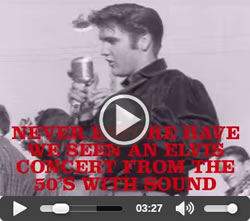Elvis At Stax Box Set Chronicles The King's Final Major Studio Sessions
Elvis At Stax Box Set Chronicles The King's Final Major Studio Sessions
August 01, 2013 -- 5:22 pm PDT
Elvis At Stax chronicles recordings Elvis Presley made at Memphis' Stax recording studios over 12 days in 1973, from July 21-25 and Dec. 10-16. Even though he was using the iconic studio where Booker T. & the MG's laid the grooves for massive hits by artists from Otis Redding and Wilson Pickett to Sam & Dave and the Staple Singers, Presley imported his own players. And after aborting the July sessions because of technical problems, he even imported a mobile recording truck for the second one.
Still, with musicians raised in Memphis, Muscle Shoals, Ala., and other Southern towns - some of whom had performed on his career-reviving 1969 sessions at Memphis' American Sound Studio - Elvis again tapped into the bluesy soul, primal R&B, rockin' gospel, country-tinged rockabilly, and rich balladry that characterized his best work.
'It was a return to a straight-ahead rock sound, a little less bombastic', says GRAMMY-winning album notes writer Robert Gordon, who penned the Elvis At Stax notes. (Memphis native Gordon's latest book, Respect Yourself: Stax Records And The Soul Explosion, will be published in November.)
'These recordings were spread over three albums [Raised On Rock (1973), Good Times (1974) and Promised Land (1975)]', he observes. 'As I was digging back into them, I was really surprised at how many good songs there were. For other people, they would have been pinnacles of achievement. For Elvis, they didn't make the mark that his earlier stuff did. But they're very substantial'.
While they wouldn't yield another 'In The Ghetto' or 'Suspicious Minds' (Elvis Presley's last No. 1 hit), the Stax sessions resulted in Top 40 singles such as 'My Boy', 'Promised Land', 'If You Talk In Your Sleep', and 'I've Got A Thing About You Baby'. Elvis also recorded Danny O'Keefe's 'Good Time Charlie's Got The Blues', the gospel rave-up 'I Got A Feelin' In My Body' and some tunes that drip rather heavily with the lush strings and backing vocals of the era's 'beautiful music' format. The sessions produced 28 tracks in all - 11 single sides and 17 album tracks.
One major distinction of these recordings is that Elvis was calling the shots for the first time. RCA Records' Ernst Mikael Jorgensen, Elvis' longtime catalog director and the box set's co-producer, notes Elvis had a new recording contract and publishing arrangement that gave him control of song selection. Just a few years prior, his '68 comeback special and '69 American Sound Studio sessions rejuvenated his fledgling career, and the 1972 documentary, Elvis On Tour, and early 1973 TV special, 'Aloha From Hawaii', bolstered his popularity. With his Hollywood film obligations fulfilled and these new deals in tow, Elvis was free to sing only what he felt like singing.
'What we see here is Elvis trying to establish a renewed sense of independence', says Gordon.
That notion, adds Jorgensen, explains why these sessions contain so many different song styles.
'I don't think Elvis ever saw himself as a rock and roll or a country or an R&B or a ballad singer', Jorgensen says. 'He wanted to incorporate all these elements of American music into his own. He even listened to [opera singers] Mario Lanza and [Enrico] Caruso when he was a kid because his mother had their records. He wanted to blend all that music into his own'.
Unfortunately, the July sessions were rather choppy. He showed up late. A persistent hum attacked the system. The gear was antiquated. Elvis joshed in the studio - in one outtake snippet, he sings 'wasted years, wasted years …' while engineer Al Pachucki tries to fix the glitch - but he left, frustrated, ahead of schedule.
In the midst of a divorce from his wife, Priscilla, and expecting a visit from daughter Lisa Marie, he wasn't exactly chomping at the bit to work, either. Her visit was the big reason he wanted to stay at Graceland, his beloved Memphis home.
By 1973, American Sound Studio had closed its doors, but Norbert Putnam, who played bass on the more successful December sessions at Stax, says there was another reason Elvis wanted a different setup: He fed off the energy of performing live with the band, preferring that situation to American Sound Studio co-owner/engineer Chips Moman's penchant for overdubbing.
'He really liked to get out there and lead the band with his emotion', says Putnam, a Muscle Shoals veteran who started playing with Elvis in 1970. 'Once he got into it, he didn't want to stop. He would do five, six, seven songs an evening … a lot of times, he got it on the first take'.
That emotional intensity is particularly evident in songs such as 'My Boy', in which a parent describes the ache of staying in a loveless marriage to his sleeping child.
Putnam says Elvis was 'totally fearless' when it came to cutting his vocals.
'For the King, it was like an athletic event', he recalls with a laugh. 'We're hanging on for dear life. He never did a conservative first take'.
If there were any weaknesses among the players, these tracks certainly don't betray them.
'They intuitively knew what Elvis wanted because they all had the same musical background', says Jorgensen. 'They grew up on country music on the radio, and R&B; they had the same musical references'.
Interestingly, Gordon points out, Stax and Elvis were both heading toward their demises. Stax fractured in 1975; on Aug. 16, 1977, the King of Rock and Roll passed away.
Putnam, who still plays Elvis' hits with the TCB Band, still marvels to this day at the King's talent and charisma.
'He changed music totally', Putnam observes. 'He took us out of the big band era with Frank Sinatra and Bing Crosby and into this very simplistic trio that he formed with Scotty Moore and Bill Black, and then he went out and sold the emotion of all that. And a whole generation of people changed their attitude about music'.
© Copyright 2024 by www.elvis.com.au & www.elvispresley.com.au
![]() https://www.elvis.com.au/presley/tcb/hold/Elvis-At-Stax-Box-Set-Chronicles-The-King-s-Final-Major-Studio-Sessions.shtml
https://www.elvis.com.au/presley/tcb/hold/Elvis-At-Stax-Box-Set-Chronicles-The-King-s-Final-Major-Studio-Sessions.shtml
No part of any article on this site may be re-printed for public display without permission.
 Tupelo's Own Elvis Presley DVD
Tupelo's Own Elvis Presley DVD
Never before have we seen an Elvis Presley concert from the 1950's with sound. Until Now! The DVD Contains recently discovered unreleased film of Elvis performing 6 songs, including Heartbreak Hotel and Don't Be Cruel, live in Tupelo Mississippi 1956. Included we see a live performance of the elusive Long Tall Sally seen here for the first time ever. + Plus Bonus DVD Audio.
This is an excellent release no fan should be without it.
The 'parade' footage is good to see as it puts you in the right context with color and b&w footage. The interviews of Elvis' Parents are well worth hearing too. The afternoon show footage is wonderful and electrifying : Here is Elvis in his prime rocking and rolling in front of 11.000 people. Highly recommended.
Tupelo's Own Elvis Presley DVD Video with Sound.





